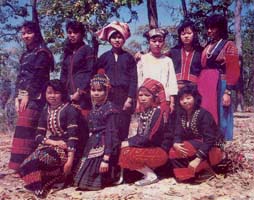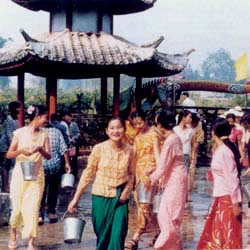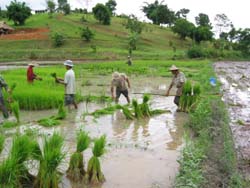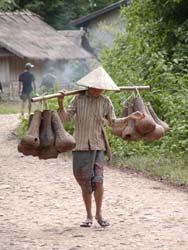Identity
The question “Who are the Shan?” seems simple enough. Yet if you spend even a week among the Shan, you will find that this question is full of complexities. The complexities are reflected in the numerous names for the Shan, including Burmese Shan, Chinese Shan, Dai, Tai (pronounced with an unaspirated “t”, like the “t” in “stop”), Thai Yai, and many more.
The term “Shan” is a corruption of the Burmese pronunciation of “Siam”, the old name for Thailand (the Thai are descendents of the Shan and call the Shan the Thai Yai, which is usually translated as “greater Thai” or “upper Thai”). The British adopted the term Shan during their colonization of Burma. Today, the Burmese continue to use the term Shan, whereas the Shan call themselves Tai. To further complicate matters, some people who are ethnically Shan do not explicitly identify themselves as Shan because, for example, they have become assimilated into other cultures (such as Thai culture) or to avoid deportation from Thailand if they are in the country illegally. The converse is also true. Members of other ethnic minorities sometimes choose to identify themselves as Shan because of their affinity with the Shan people (e.g., they might live in Shan State and use Shan as their main trade language).
Even the number of different kinds of Shan people is disputed. Reports by Shan people vary from 12 or 13 to 36 or more. The following are several of the primary Tai peoples considered to be Shan: Tai Nue (Northern or Chinese Shan), Tai Mao (Shan along the China / Shan State border), Tai Long or Thai Yai (Shan State, Thailand), Tai Khun, Tai Laeng (Kachin, Shan State Border), and Tai Loi (Mountain Shan / Hill Shan). There are many other “Tai” groups that are ethnically related to the Shan (such as the Tai Lue and Tai Yuan) but who do not classify themselves as being Shan.
Language
The Shan speak Tai, a tonal language related to Thai and Lao. Although the various dialects within the Tai language family are distinct, they are similar enough that a person who speaks one of them can understand many things said in an ordinary conversation in another. Discussions of more complicated topics (such as emotional and spiritual matters), however, often are not mutually intelligible.
Despite their similarities, many of these languages have separate scripts. For example, the Tai Long script resembles Burmese; Tai Mao resembles an angular Tai Long; and Tai Khun and Tai Lue resemble Northern Thai. The scripts were primarily used for religious texts and court chronicles. Even today, most of the books available in Tai scripts are Buddhist literature. Thus, it is not surprising that most Shan men learn to read and write Tai when ordained as novices or monks. In fact, throughout the Shan State, temples are often the only avenues where Tai scripts are taught and learned.
While the younger generation of educated Shan can read their national languages, only a few can read and write the traditional Tai scripts of their dialects. Regardless of how many Shan can actually read the Tai scripts, however, almost all Shan speak a Tai dialect. In fact, these Tai dialects are their heart languages, the languages with which they think and feel. As such, it is necessary for the Word, both verbal and written, to be communicated in their heart languages. (See also Shan Bible Translations.)
Traditions
The Shan have a rich cultural heritage, including many unique customs and traditions.
One such custom is the wedding ceremony. In traditional Shan marriages, the groom’s parents ask the bride’s parents for permission to marry. If her parents consent, a dowry is exchanged and a traditional wedding takes place. Usually the uneducated girls marry as young as fifteen or sixteen. Educated women typically wait until their early twenties before they marry. The weddings usually take place at a relative’s house and the celebration can last up to three days. As many as three hundred guests are invited and fed throughout the duration of the wedding. The house is divided into rooms of honor, according to the particular position of honor of the wedding guests (e.g., family, friends, village-prestige).
 |
Funerals
The importance of funerals in Shan culture cannot be underestimated. An acceptable funeral costs a minimum of six months wages. Funeral attendance is very important not only to respect the deceased but also to ensure attendance at one’s own funeral. A bad funeral can bring great shame on the family of the deceased and a good funeral can bring great merit. The Shan either bury or cremate the body of the dead person. Cremation is the more traditional practice because the complete burning of the remains makes sure that the person cannot return as an evil spirit, especially if the person was killed in a bad way.
The Shan live among many other ethnic groups. This photo shows a few of these groups wearing their traditional costumes.
 |
The Shan also celebrate traditional Buddhist holidays four times a month. A good example of this is the Songkran (the Water Festival); the Shan celebrate this holiday by dumping buckets of water on anyone in sight. This also marks the beginning of the Buddhist New Year.
 |
Traditional Shan dress is colorful and varies among the different sub-groups (Tai Long, Tai Nue, etc.). Women tend to wear a wrap-around tube skirt called a longgyi (or sarong) and a snug-fitting blouse. While older women traditionally wear their hair up in a bun, younger women often wear their hair down or in a long braid. Women, especially in the villages, may also wear head towels and smoke pipes. Men traditionally wear baggy trousers with a button-up Shan-style collarless shirt and occasionally a turban. Often, however, the Shan choose to adopt the clothing of the majority culture. In Thailand, for example, both Shan men and women wear Western-style dress, while in Burma some Shan men choose to wear the longgyi, which is also worn by most Burmese men, with a variety of styles of shirt (including t-shirts).
Livelihood
The Shan rely on several means of production for their livelihood. A lack of available technology in rural areas necessitates a dependence upon traditional systems of manual labor (such as plows drawn by oxen or water buffalo). Most Shan are farmers who cultivate rice, vegetables, soybeans and fruit. Some mine for rubies and various precious stones; others harvest teak. Urban Shan take on a variety of jobs, including operating small stores and stalls in markets. Prior to 1996, the Shan in Burma were responsible for approximately 50% of the world’s opium production. After the surrender of their leader Khun Sa to the Burmese in February of 1996, the cultivation and sale of illegal opium by the Shan drastically dropped. Unfortunately, some of the Shan have not given up this source of income.
 |
 |


